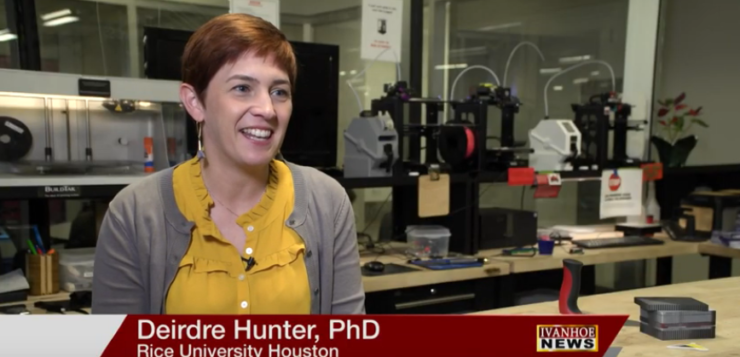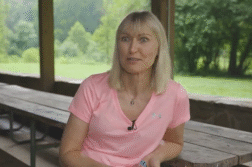Deirdre Hunter, PhD, Lecturer of Engineering Design at Rice University Houston talks about her students creating EpiWear and how it could beneficial to those with severe allergies.
Interview conducted by Ivanhoe Broadcast News in May 2019.
Can you tell me a little bit about these students and what they did here?
HUNTER: Yes. I’m a lecturer at Rice University as part of the School of Engineering. And I teach in a program that’s an engineering design minor. Our students work on design ideas. So it’s a way for them to apply the technical knowledge that they’re learning in their classrooms in really practical ways to solve real world problems. So this course in particular that these students were in is called ENGI 200 and it’s a studio in engineering design. They start with a problem that they want to solve and develop an idea and a concept. Then they spend an entire semester prototyping and building a solution to this problem. Figuring out what are the limits and what can be possible, testing and refining their design over the course of several weeks.
What was your reaction when you first heard their idea?
HUNTER: It was actually in the end of last semester. A couple of students came to me and said hey, we want to take your class. But we want to bring our own project to the class. And most of my classes I pitch the projects to the students. And they choose. These students were motivated by their own project idea. And they said we think it fits in your class, can we take your class? And I was like well let’s talk about the project. And when they first pitched the idea of building a wearable epinephrine injection device, I was like, OK. That’s bold. And ambitious and like the scope of that project is pretty large, right? For a one semester course. But they are upper level students. They had a personal motivation. And they were very strong students. I’d interacted with a couple of them prior. So I knew that their dedication to the project was there. And so it’s more about mentoring them through the technical parts of the process. But I was excited and nervous. They were taking on a big project. It wasn’t going to be a minor type of thing.
What was your reaction when they got as far as they did?
HUNTER: Wow. I don’t want to say I was surprised about how far they got because I really trusted in the process of engineering design and they’re bringing of their own technical skills to the project. But to actually see the thing actually inject a needle into a proxy for flesh and then actually inject fluid, that was a great success. And to see that the device works in tandem, it’s repeatable. It can happen over and over again. And it’s such a simple mechanism and device. I was really excited to see the conclusion.
Do you think it says anything about if there is a personal connection to what you’re trying to create?
HUNTER: Yeah. I think with a lot of our projects, students do choose to work on projects because of a personal connection. We bring projects to our students usually from the developing world. But also low resource settings. But a lot of times it’s people with diabetes or people with breathing problems or people with allergies in low resource settings, how do we bring a device to them that can use their local resources to solve problems that are solved a lot of times in the U.S. but with more expensive devices. So a lot of students do feel like they choose projects because of personal connections. For this project in particular, the student who initiated the project is himself an EpiPen user, it gave them a strong motivation to finish and complete the project. But I would say with all of our projects students work with clients. And I think that’s a strong motivation when you see the face of your client and know that whatever I’m able to create over the course of the semester is going to impact the life of this client, I think that’s a huge motivating factor for our students to complete projects. And complete them successfully with devices that work and function.
Because you’re putting a face on this problem.
HUNTER: Right.
Can you tell me from your perspective why is this a big deal? Why should someone who’s watching this at home care about this class?
HUNTER: I think this device could be really important and really impactful for a lot of people. So many people know that they have allergies, have a prescription for something like epinephrine but don’t carry it on them. And those first two moments of having an allergic reaction are the most vital and critical. Yet it’s estimated that 60-70% of patients do not regularly carry their EpiPen. And so the reality is that people that end up dying from anaphylaxis, of those that die from allergy induced anaphylaxis approximately 85% of them didn’t have an epinephrine pen on them at the time of their allergic reaction. So these moments, these first two minutes are really critical in survival. And everyone knows somebody that has allergies. When the students brought their project to me, I mean, I kind of smirked because I have an epinephrine pen that I rarely carry on my person. So I think the idea that you’re transforming the way we think about these medical lifesaving devices and how we can carry them on us will really impact a lot of people. And a lot of people in really vulnerable situations.
So if this moves forward is this something you would buy?
HUNTER: Oh, yeah. For sure. If this is something that moved forward it would definitely change the way I interact with my epinephrine device. And I can see it being a widespread device that is in elementary schools on the wrists of elementary school children or on the wrists of all allergy sufferers as an everyday kind of thing that blends in with your lifestyle.
Awesome. Anything else you’d like to add?
HUNTER: I’m really excited for these guys because this summer they’re working with Owl Spark which is an entrepreneurship program, two of them will look at the business development side of it. You know, they still need to work on the design side of it. It works and functions. But to get it to market it needs more further development on the design side. But I think during this summer break from the design work and thinking more about the entrepreneurial side. The business side will give them that motivation to continue the design work maybe in August when the school year starts again. Or I know someone will tinker with it over the summer. But to really kind of put a lot of effort back towards refining the design.
END OF INTERVIEW
This information is intended for additional research purposes only. It is not to be used as a prescription or advice from Ivanhoe Broadcast News, Inc. or any medical professional interviewed. Ivanhoe Broadcast News, Inc. assumes no responsibility for the depth or accuracy of physician statements. Procedures or medicines apply to different people and medical factors; always consult your physician on medical matters.
If you would like more information, please contact:
Mike Williams
713-348-6728
Sign up for a free weekly e-mail on Medical Breakthroughs called First to Know by clicking here




